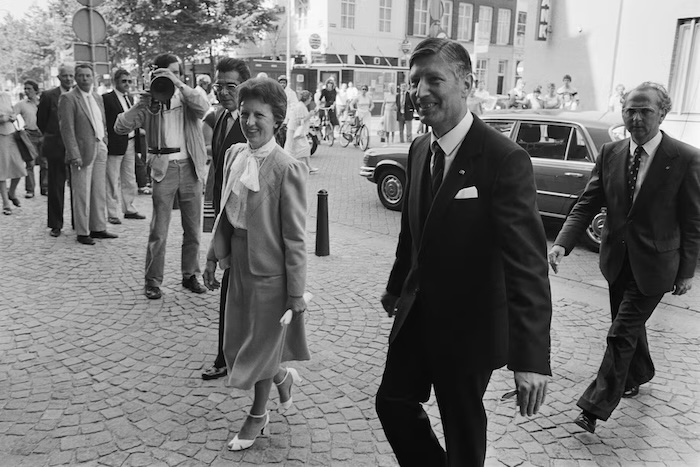— In the Netherlands, a famous couple chooses to die together

The vow is “til death do us part.” But for former Dutch prime minister Dries van Agt and his wife, Eugenie, the aim was to leave this life the same way they had spent the past seven decades — together.
The couple, both 93, died “hand in hand” earlier this month, according to a statement from the Rights Forum, a pro-Palestinian organization that Dries van Agt created. They chose to die by what is known as “duo euthanasia” — a growing trend in the Netherlands, where a small number of couples have been granted their wish to die in unison in recent years, usually by a lethal dose of a drug.
A longtime politician who had conservative roots but campaigned for numerous liberal causes, van Agt served as prime minister of the Netherlands from 1977 to 1982. He later became the European Union’s ambassador to Japan and the United States
Photos of the couple from their decades-long careers as public figures often show them walking in step: waving to crowds through a car window, voting together at an election site and giving each other a smooch at a public event.
The van Agts’ health had declined in recent years, Dutch public broadcaster NOS reported. The former prime minister never fully recovered after suffering a brain hemorrhage in 2019, which happened while he was delivering a speech at a commemoration event for Palestinians. Eugenie’s health issues were largely kept private.
“I feel like it’s kind of beautiful, honestly, that you’ve lived your life together, you both happen to be gravely ill without a chance of getting better, you’re ready to go, and you would like to go together,” said Maria Carpiac, director of the gerontology program at California State University at Long Beach.
When it comes to the right to choose one’s own death, the Netherlands is “kind of the model” for any U.S. legislation on the topic, she said.
At least 29 couples — or 58 people — died together via duo euthanasia in 2022, the most recent year of data from the country’s Regional Euthanasia Review Committees. That’s more than double the 13 couples who did so in 2020, when the committee first started looking at partners specifically, but it still represents only a small fraction of the 8,720 people who legally died by euthanasia or assisted suicide in the Netherlands that year.
“It is likely that this will happen more and more often,” said Rob Edens, press officer for NVVE, a Dutch organization focused on research, lobbying and education about assisted suicide and euthanasia in the Netherlands. “We still see a reluctance among doctors to provide euthanasia based on an accumulation of age-related conditions. But it is permitted” in the country’s legal guidelines, he said in an email.
Assisted suicide is when a person self-administers a lethal dose while a physician is present, while euthanasia is when a medical professional administers the dose. Both are legal in the Netherlands when specific criteria are met. (Some groups prefer the term “medical aid in dying,” or MAID, due to religious and social stigma around suicide.)
Euthanasia is illegal in the United States, but assisted suicide is allowed in D.C. and at least 10 states: Oregon, Washington, Montana, Vermont, California, Colorado, Hawaii, New Jersey, Maine and New Mexico. Eligibility requirements tend to be strict across the country, Carpiac said, but there are differences between jurisdictions.
The Netherlands, a country of almost 18 million people, has allowed assisted suicide and euthanasia since 2002. It requires that individuals willingly request the termination of their life in a manner that is “well-considered,” with a sign-off from a doctor that they are experiencing “unbearable suffering with no prospect of improvement.”
Another physician then has to agree that the person qualifies, and doctors can choose whether they are involved in the procedure. After every death, doctors are required to notify a regional review committee, which examines whether each case was handled lawfully. Couples who seek duo euthanasia are required to apply and undergo the review process individually, with separate doctors.
“An accumulation of age-related complaints can lead to unbearable and hopeless suffering,” Edens said, explaining the Dutch guidelines. “The expectation is that if doctors are increasingly willing to provide euthanasia when there is an accumulation of old-age complaints, the number of duo euthanasia [cases] will increase.”
Research suggests that older Americans are at a higher risk of dying after losing a spouse, particularly in the first few months after their death. While the cause of this phenomenon is unclear, studies have found that grieving partners have higher rates of inflammation and are at increased risk of heart attack and stroke, often due to stress-induced changes in blood pressure, heart rate and blood clotting.
“The first thing that came to my mind was the widowhood effect,” Carpiac said, referring to the van Agts’ choice to die by duo euthanasia. “I have a grandmother who is 96, and she’s like, ‘I’m not going anywhere!’ But if I had a partner and they were my person, and we were both kind of at the end of our lives, would it be worth it if he were to go without me? Would I die of what I considered to be a broken heart? I would want to have a choice.”
Complete Article ↪HERE↩!
